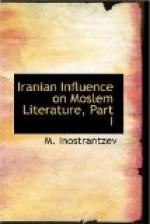This is the first book to be translated from Russian into English by an Indian and the obvious difficulties of the task may be pleaded to excuse some of the shortcomings of a pioneer undertaking. I look for my reward in on awakened interest in Arabic books which hold in solution more information on Persia than any set work on the history of Iran.
It would not be in place to advert to the present state of hapless chaos in Persia. The most sympathetic outsider, however, cannot help observing that her misfortunes are less due to her neighbours and their mutual relations than to her too rapid political strides and adoption of exotic administrative machinery repugnant to the genius of the ancient nation. Whatever the attitude of individual Mullas towards non-Moslems in the past the central authority and the people as a whole are actuated to-day with a spirit of patriotism which is still the keynote of the character of Persia’s noble manhood and womanhood. It declines to make religion the criterion of kinship.
The inconsistency in the spelling of Arabic words has not altogether been avoidable being due partly to a desire to adhere to the orthography adopted by authors whom I have consulted.
Simla, G.K. Nariman.
September, 1917.
CHAPTER I
Iranian literary tradition in the opening centuries of Islam 1
The character of the Persian history during the Sasanian epoch 6
Importance of this epoch according to the Arab writers of the first centuries of Islam 10
The position of the Parsi community and the centres of the preservation of Persian tradition during the period of the Khalifat in Tabaristan, Khorasan and Fars 15
The castle of Shiz in the district of Arrajan in the province of Fars described by Istakhri, p. 118, 2-4; 150, 14-7; Ibn Hauqal, p. 189, 1-2; cf. the translator of the Khoday Nameh, Behram, son of Mardanshah of the city of Shapur in the province of Fars 19
This castle was the residence of those acquainted with the Iranian tradition (the badhgozar) and here their archives were lodged 20
ARABIC WRITERS AS SOURCES OF SASANIAN CULTURE.




